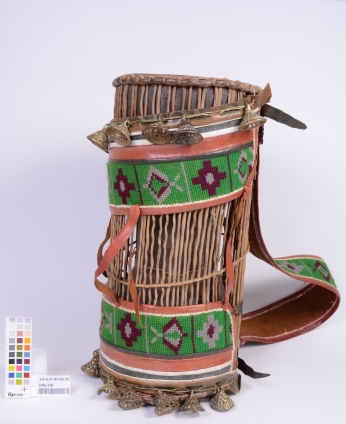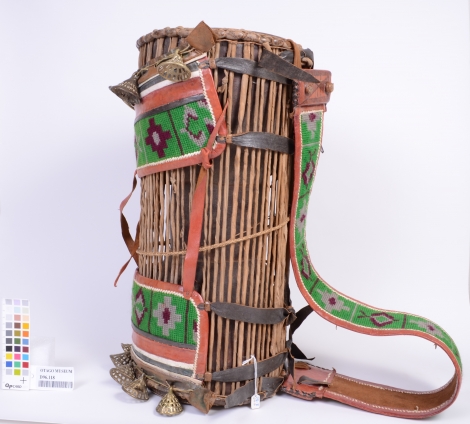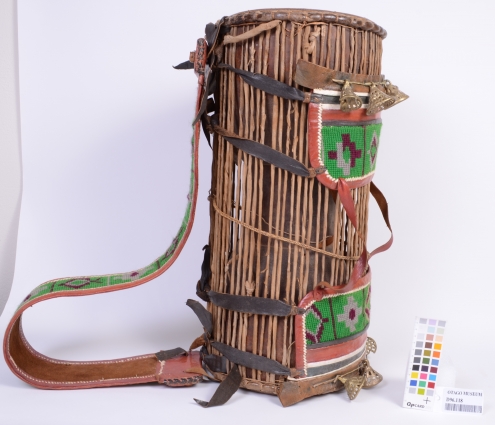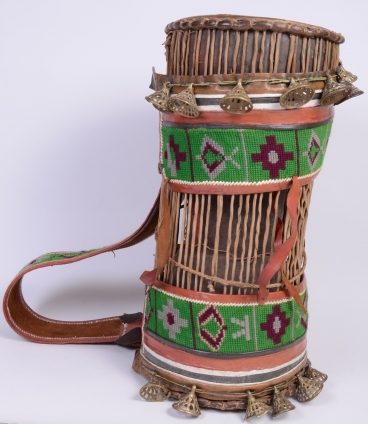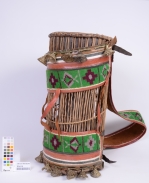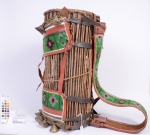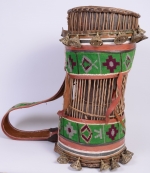Drum, D96.118
Physical Description
Hourglass shaped wooden drum body. Over each end is placed a skin, often goat skin. Strong twisted leather straps run through the edge of one skin along the length of the wooden body and through the edge of the skin on opposite end. This leather strap is sewn alternately from one end to the other until the full circumference of each skin has been sewn and thus tied to the skin on the other end. (Squeezing these strings between the drummer's arm and body changes tension on drum skins thereby varying the tone produced when skins are struck.) The leather strings/strap are sewn around through the skins 72 times, i.e. giving the appearance of 72 leather strings tying the skins together. To give strength to the skins of the drum head a strong rolled length of leather is sewn by means of a thin leather thread to the circumference of the skin. It is at the binding points of this stitching through which the stronger leather strings are sewn which run back and forth between the two skins tying them one to the other. The drum is held by the drummer through the construction of a corset like container, composed of two wide (approx. 146mm) flat leather belts -each approx. half the circumference of the drum - onto which a panel of green, maroon, and gray yarn cross stitching has been sewn with white leather edge binding on to the red leather belts. The cross stitching creates a series of subpanels of 6 symbols on each belt. In turn the belts are tied with red leather straps one to the other across the length of the drum, and then around the circumference of the drum - thereby holding the leather belts to the drum. A large red leather shoulder strap with the same cross stitching and white leather binding is attached to either end of the drum with narrow leather straps. Also, 7 small brass (cire perdue) bells are tied to the circumference of each of the belts and which jingle when they strike one another. The appearance is of an older drum body and cords to which a more recent shoulder strap and corset have been attached. General appearance is of a well used Dundun Iya Ilu ('talking drum') in good condition. The leather skin drum head has partially separated.torn from its leather attachment on one end.
Length (drum head to drum head) = approx. 523 mm. diameter at drum heads = approx. 228 mm & approx. 230 mm. diameter at middle of hour glass wooden body = approx. 132 mm. Width of leather corset belts = approx. 146mm. Length of shoulder strap = approx. 900 mm. Width of shoulder strap = approx. 92 mm.
Length (drum head to drum head) = approx. 523 mm. diameter at drum heads = approx. 228 mm & approx. 230 mm. diameter at middle of hour glass wooden body = approx. 132 mm. Width of leather corset belts = approx. 146mm. Length of shoulder strap = approx. 900 mm. Width of shoulder strap = approx. 92 mm.
Research Notes
Yoruba
Western Nigeria (West Africa)
Body of drum = wood. Drum heads, wrapping, shoulder strap = leather. Shoulder strap = cloth. Sewing around drum heads = thread (cotton?). Bells = brass.
The principal drum of the Yoruba, i.e. Iya = Mother, i.e. the Mother Drum. Used in ceremonies and celebrations. With main strap over right shoulder, drum is carried under left arm. Played by striking drum skin with curved wooden stick and sometimes by hand. Simultaneously the leather straps are squeezed between arm and hip, stretching or relaxing drum skins and varying the tone. Actually speaks Yoruba language - which is a tonal language.
Hourglass shaped wooden drum body. Over each end is placed a skin, often goat skin. Strong twisted leather straps run through the edge of one skin along the length of the wooden body and through the edge of the skin on opposite end. This leather strap is sewn alternately from one end to the other until the full circumference of each skin has been sewn and thus tied to the skin on the other end. (Squeezing these strings between the drummer's arm and body changes tension on drum skins thereby varying the tone produced when skins are struck.) The leather strings/strap are sewn around through the skins 72 times, i.e. giving the appearance of 72 leather strings tying the skins together. To give strength to the skins of the drum head a strong rolled length of leather is sewn by means of a thin leather thread to the circumference of the skin. It is at the binding points of this stitching through which the stronger leather strings are sewn which run back and forth between the two skins tying them one to the other. The drum is held by the drummer through the construction of a corset like container, composed of two wide (approx. 146mm) flat leather belts -each approx. half the circumference of the drum - onto which a panel of green, maroon, and gray yarn cross stitching has been sewn with white leather edge binding on to the red leather belts. The cross stitching creates a series of subpanels of 6 symbols on each belt. In turn the belts are tied with red leather straps one to the other across the length of the drum, and then around the circumference of the drum - thereby holding the leather belts to the drum. A large red leather shoulder strap with the same cross stitching and white leather binding is attached to either end of the drum with narrow leather straps. Also, 7 small brass (cire perdue) bells are tied to the circumference of each of the belts and which jingle when they strike one another. The appearance is of an older drum body and cords to which a more recent shoulder strap and corset have been attached. General appearance is of a well used Dundun Iya Ilu ('talking drum') in good condition. The leather skin drum head has partially separated.torn from its leather attachment on one end.
Length (drum head to drum head) = approx. 523 mm. diameter at drum heads = approx. 228 mm & approx. 230 mm. diameter at middle of hour glass wooden body = approx. 132 mm. Width of leather corset belts = approx. 146mm. Length of shoulder strap = approx. 900 mm. Width of shoulder strap = approx. 92 mm.
Dundun iya ilu —Joel A Vanderburg
Western Nigeria (West Africa)
Body of drum = wood. Drum heads, wrapping, shoulder strap = leather. Shoulder strap = cloth. Sewing around drum heads = thread (cotton?). Bells = brass.
The principal drum of the Yoruba, i.e. Iya = Mother, i.e. the Mother Drum. Used in ceremonies and celebrations. With main strap over right shoulder, drum is carried under left arm. Played by striking drum skin with curved wooden stick and sometimes by hand. Simultaneously the leather straps are squeezed between arm and hip, stretching or relaxing drum skins and varying the tone. Actually speaks Yoruba language - which is a tonal language.
Hourglass shaped wooden drum body. Over each end is placed a skin, often goat skin. Strong twisted leather straps run through the edge of one skin along the length of the wooden body and through the edge of the skin on opposite end. This leather strap is sewn alternately from one end to the other until the full circumference of each skin has been sewn and thus tied to the skin on the other end. (Squeezing these strings between the drummer's arm and body changes tension on drum skins thereby varying the tone produced when skins are struck.) The leather strings/strap are sewn around through the skins 72 times, i.e. giving the appearance of 72 leather strings tying the skins together. To give strength to the skins of the drum head a strong rolled length of leather is sewn by means of a thin leather thread to the circumference of the skin. It is at the binding points of this stitching through which the stronger leather strings are sewn which run back and forth between the two skins tying them one to the other. The drum is held by the drummer through the construction of a corset like container, composed of two wide (approx. 146mm) flat leather belts -each approx. half the circumference of the drum - onto which a panel of green, maroon, and gray yarn cross stitching has been sewn with white leather edge binding on to the red leather belts. The cross stitching creates a series of subpanels of 6 symbols on each belt. In turn the belts are tied with red leather straps one to the other across the length of the drum, and then around the circumference of the drum - thereby holding the leather belts to the drum. A large red leather shoulder strap with the same cross stitching and white leather binding is attached to either end of the drum with narrow leather straps. Also, 7 small brass (cire perdue) bells are tied to the circumference of each of the belts and which jingle when they strike one another. The appearance is of an older drum body and cords to which a more recent shoulder strap and corset have been attached. General appearance is of a well used Dundun Iya Ilu ('talking drum') in good condition. The leather skin drum head has partially separated.torn from its leather attachment on one end.
Length (drum head to drum head) = approx. 523 mm. diameter at drum heads = approx. 228 mm & approx. 230 mm. diameter at middle of hour glass wooden body = approx. 132 mm. Width of leather corset belts = approx. 146mm. Length of shoulder strap = approx. 900 mm. Width of shoulder strap = approx. 92 mm.
Dundun iya ilu —Joel A Vanderburg
Provenance
Locality:
Nigeria
Measurements
Maximum dimensions (H x W x D): 530 x 510 x 260mmAll Rights Reserved

